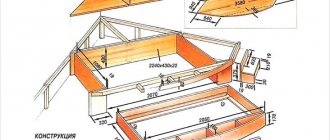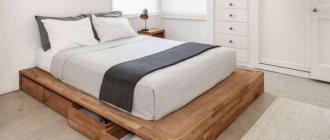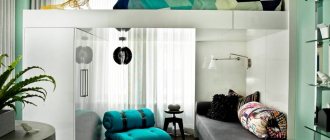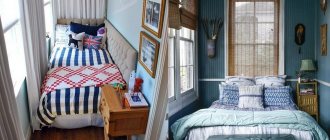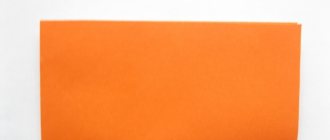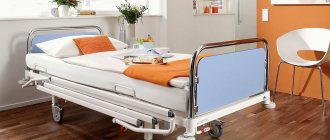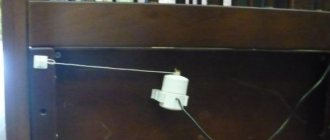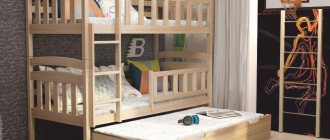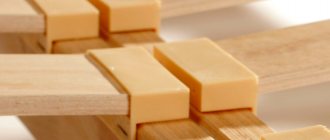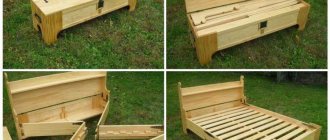Just think about which piece of furniture takes up a huge amount of space in our small-sized homes? Of course it's a bed. Many people prefer to purchase compact folding sofas to save space. But not even the most comfortable sofa can replace the feeling of relaxation and comfort that you can experience while relaxing on the bed.
That is why folding beds, or, as they are also called, lifting beds, have become increasingly popular.
Design
Hanging bed - an unusual design solution in the bedroom interior
Any bed, regardless of shape and configuration, consists of the following components:
- Frame
- Base
- Side and support panels
- Optional design elements (legs, hanging backrests, headboard, storage drawers, lifting mechanism)
A home-made sleeping place usually consists of a frame on which a base is installed - a mattress support. The supporting structure is made from:
- wooden slats (slats)
- metal mesh
- spring mechanism
Furniture for sleeping and relaxation can:
- have legs (most often no more than 20 cm high)
- be floor-standing (the frame is located directly on the floor)
- be suspended (fixed to the ceiling)
Original headboard for bed
The headboard is a decorative element that:
- carved from wood
- sawn from chipboard
- forged from metal
- upholstered with foam rubber and fabric
- can be carved and solid, straight and curved
In addition to the main functionality - a place to rest, the bed also serves as:
- closet
- stand
- sofa
- podium
In these cases, the mattress is hidden in the shell of the body during the day, and at night it is unfolded using a “book” mechanism or a gas lift.
Swimming pool at the dacha: device, step-by-step instructions for arranging it yourself | 65+ Photos & Videos
The final stage is decoration
The facade of the final product is often decorated with false doors - an overhead element that is part of the decoration, onto which handles are attached. Do not use mirrors in such beds under any circumstances, as they are not designed for such loads and may soon crack.
Even the simplest folding bed design can fit into any room interior.
This will also affect the weight of the structure being lifted, which may affect the durability of the mechanism. Be sure to install the legs into the pre-drilled holes and magnetic latches. Now the work is completed, and the new decoration of your interior is completely ready for your relaxation.
A single folding bed can be installed in the front room, and no one outside will even think about its presence, since it will be disguised as a closet.
DIY bed headboard
To get an attractive product, you can preview the master class
It is important to perform all steps sequentially:
- preparation of necessary tools and materials;
- frame installation;
- fastening the filler;
- fixation of finishing material;
- performing a screed (when you need to create a pattern or ornament on the surface of the structure).
If you are deciding how to make a headboard with your own hands, consider the option of decorative finishing. This can be embroidery or a pattern on woven material. Then the upholstery is first decorated, then it is used to finish the finished headboard frame.
Materials and tools
To work you will need:
- jigsaw;
- hammer;
- electric drill;
- saw;
- sharp knife;
- scissors;
- furniture stapler;
- sandpaper;
- Sander;
- wood brush.
If old wood is used to make the base (furniture elements, window frames, etc.), you need to carefully prepare it: remove the coating, cut the wood according to the dimensions of the headboard, then sand it.
There is no need to additionally paint the wood, since the structure will be located in the bedroom, and the likelihood of contact with water in this room is extremely low. However, if the house is damp or is located in an area with a humid climate, it is better to protect the wood with a primer. These works are performed at the initial stage, before installation begins.
You will need the following materials:
- fastening elements: nails, self-tapping screws for woodworking, furniture nails;
- primer composition;
- glue;
- filler: foam rubber or synthetic winterizer;
- upholstery: fabric, leather, leatherette, etc.;
- frame material: wood or its derivatives (plywood).
Separately prepare the fasteners for installing the headboard on the wall. This option will allow you to obtain the most reliable design. If you attach the product to a piece of furniture, it will wobble, which will eventually lead to breakage.
Preparing the back frame
If the bed is already equipped with a headboard, but it has lost its appearance or has become deformed over time, you need to remove the upholstery and restore the frame. If necessary, change the dimensions of the structure. To do this, you need to increase the height using bars (50x50 mm). You can fasten the structural elements using metal plates and glue on the side of the back that will not be visible.
If the bed does not have a headboard, you will have to make one yourself. The boards need to be laid on a wooden frame with a minimum pitch (3-5 mm) or closely. It is necessary to take into account the humidity in the room. To secure MDF or plywood to the frame, prepare a sheet whose dimensions will correspond to the dimensions of the base.
We fix the foam and fabric
When the base is ready, cut out the foam. It doesn't have to be attached. If you plan to screed the upholstery, the fastening elements will also hold the filler. However, over time, the foam rubber can become deformed and sag in places, which will worsen the appearance of the product.
The filler is placed with the cellular side facing the frame. The material is laid in 1 or 2 layers. To avoid sagging of the filler, we fix the foam rubber using an adhesive. You don't need to do this on each side. It is enough to attach the filler to the frame. A furniture stapler is also used for this purpose, fixing only at the bottom.
At the next stage, you can cover the product with upholstery material. The piece of fabric or leatherette must exceed the area of the base. A margin of about 20 cm is made on all sides. Thanks to this, it becomes possible to close the end sections of the wooden frame and fix the material on the back side of the structure. This task is performed using a furniture stapler or furniture nails. To prevent the woven material from unraveling, its edges are tucked.
Fastening the fabric
After the headboard has been covered with upholstery material around the perimeter, you need to pay attention to the corner areas. There should be no fastening elements on the front side
To make the product look neat, the material should be stretched before fixing. A fold is formed in the corner areas. This should be done by pulling the fabric in two directions: the side edge - to the sides, the end - up. The steps are repeated when forming corner folds at the bottom of the headboard.
What types of folding beds are there?
Folding sleeping places, or, as they are also called, transformable beds, come in different types. They are selected based on the interior of the house and focusing on taste preferences.
A wall folding lift bed is secured to a concrete or brick surface. It is important that the wall can support a lot of weight, so plasterboard partitions are not suitable for installing the structure.
The body, which looks like a box, completely includes a bed with a mattress and even a bed, which simplifies getting ready for work in the morning. The entire structure is securely fastened with fasteners. If shock absorbers are used in the manufacture, the stock folds easily. Even a child can do this.
Folding furniture is an excellent choice for those who have little space in their apartment. Its mechanism and frame are easy to assemble. Even a novice craftsman can make a folding bed, but it will look presentable. The furniture will fit perfectly into almost any interior.
It is convenient to use folding or folding sleeping places. They appear in the room at the right moment, and at other times they carefully hide. Any housewife will like the fact that transformers, when assembled, do not become dust collectors.
You also need to remember the disadvantages of a folding bed: it is difficult to transport to another place, and it will take a lot of effort to manufacture and assemble. But as a result, you can be sure that the product is made reliably and with high quality.
Headboard made of textile or leather: Classic version
Modern people are increasingly striving for individuality, both personal and in interior design. We began to refuse the same standard furnishings purchased in the store, giving preference to designer or hand-made ones.
When coming up with a bed headboard design, there is plenty of room for your creative soul to explore. If you already have a bed and it performs its functions, but is not satisfied with its appearance, you can update the headboard of the bed at no extra cost - cover the frame with fabric or eco-leather. This option has several advantages.
Textiles are very popular in bed headboard designs.
Properly selected light and shade together will create a special atmosphere in the room
- Decorative textiles are an affordable material that comes in a lot of interesting colors. It can be matched to curtains, pillows, or, on the contrary, made into a bright accent.
- A soft headboard protects against shocks and drafts, and envelops you in an aura of warmth and comfort. If you like to read before bed, then leaning on it will be more pleasant than on a wooden one.
- Easy and quick to do with your own hands. Take a sheet of plywood or an existing headboard. Cut out the shape with a jigsaw. Attach the foam rubber, wrap it in fabric, and secure it on the reverse side using a furniture stapler.
Soft headboard protects against impacts
Eco-leather will look great against the background of the bed
The headboard of the bed can be decorated as you like
Textile and leather headboards look good in classic, calm interiors, as well as in neoclassical and art deco style.
A mosaic of pillows of different sizes and colors attached directly to the wall will help you decorate a wall or decorate the head of a bed in an unusual way. You need to secure a rod or slats to the wall in advance. Loops or ties are sewn to the pillows. We make pillowcases from natural fabrics, which we remove and wash when dirty. The colors are selected according to your taste and the main tones that are present in the bedroom.
3D wallpaper will perfectly complement the bedroom interior
A wooden headboard that extends to the ceiling perfectly complements the overall interior of the room
The design of the headboard should be made in the style of the room
Making a bed
A bed that folds down and fits into a niche in the wall is ideal. The width and length of the product will be slightly less than the width and length of the niche.
In order for the bed to fit easily into the wall, it is necessary to make the correct calculations. The standard dimensions of a single bed are as follows: width – 80 centimeters, length – 160.
- We make the frame from chipboard and planks. Keep in mind that the device must be strong and at the same time light. It is better to make the front supports (legs) as a solid wall and attach them to hinges.
- We install the lifting mechanism. It is best to purchase gas elevators to make a lift out of them. Based on the weight of the bed, choose the power of the elevators. Attach the lifting parts to the sides of the bed and the niche.
- Then install the shock absorbers. First from below, then from above. Some craftsmen use articulated hinges. This is done if a single bed with a light bed is designed.
- After the frame is installed and constructed, the lifting mechanism is installed, proceed to laying the mattress and securing it with specialized belts. Mattresses are sold with straps or separately.
- At the end of the work, install the niche doors if it is supposed to be closed. This is the best option, since the bed in the niche should not be visible.
Built-in folding beds are also good because you can increase their functionality by placing convenient shelves or spacious cabinets on the sides. Place flowers or books on the shelves. They will look harmonious with the doors behind which the bed is hidden.
The last step will be to test the structure. This is the most pleasant thing - lying on a bed you created with your own hands.
Lift bed materials
In order not to delay the manufacturing process, the construction budget had to not be reduced at all. For the frame, ready-made laminated boards with a cross-section of 250x28 and a length of 2.5 meters were purchased and cut to size right in the store. Two boards 1700 mm long and two boards 2000 mm long. The shelves at the top of the bed are cut from three laminated spruce boards with a cross-section of 250x17 mm. Although the boards were planed and glued, they needed additional sanding. Be careful when purchasing boards. The first grade mark is placed on all lumber. Among the laminated boards there are specimens with severe curvatures and defects in the canvas. The sketch does not show three pieces of support for the mattress when it is raised. These boards were cut from unplaned boards and machined to size using an electric planer. Plywood of the required size was not sold in construction stores and therefore was purchased at a wholesale warehouse. Two piano hinges were purchased as hinges. The situation with fasteners in 2006 was also different from the current one (2011); dowels and long screws were purchased to assemble the bed. During the installation of the bed, additional corners and screws were purchased.
Diagram of assembly and installation of the bottom
The installation of hinges must be taken with full responsibility
Important! When lowered, the bottom of the bed should rest on a lower support made of plywood with a section of 300x20 mm
1. From the bottom of the bottom, mark a line at a distance of 150 mm from the edge - this is the axis of rotation.
2. Align the line with the axis of rotation of the piano hinges and mark the centers of the holes for attaching the hinges.
3. Use a thin drill to drill guide holes to a depth of 10-15 mm.
4. Fasten the loop with self-tapping screws. 5. Attach the lower support to the bottom. There should be contact between the support and the bottom.
6. Mark the centers of the holes. Drill pilot holes. 7. Fasten the loop with self-tapping screws. 8. The support should rotate on its hinges without any problems. 9. We attach the mattress support board to the bottom with self-tapping screws, which we additionally reinforce with triangular gussets. 10. To lower the bed, we make a bed pulling loop from a strong tape, which we staple to the inside of the bottom.
Mattress Support and Gusset Attached Loop Loop Attachment Bed Pull Loop
11. We try on the bottom and support to the frame; if all dimensions are correct, then the bottom should fit into the frame with minimal gaps. We attach the lower support to the frame. 12. The lower support in the center is additionally secured with a block. 13. Check the operation of the mechanism. By moving the center of gravity of the bottom inside the frame, a bed clamp is not required.
Fastening the lower support Additional fastening Checking the operation
In the process of constructing the bed, it was planned to attach counterweights to the mattress support board to make opening and closing the bed easier, but they were not needed.
How does a folding bed work?
The operating principle of a transforming piece of furniture is quite simple. There are 3 types of lifting mechanism.
Spring is a budget choice. Although springs can withstand a lot of weight and load, they quickly wear out and fail.
The gas mechanism operates on shock absorbers, which makes it more reliable and convenient to use.
In contrast, the stock is also equipped with manual lifting on hinges. Although this mechanism is much simpler to manufacture than the previous two, it is also much more difficult to use. To fold or unfold a sleeping place, you need to put in a lot of effort.
Talking module
The emptiness of the internal volume of the stationary support against the wall aroused the imagination. A life-worn soft talking toy with long-dead batteries came to hand. After dissection, the circuitry of the electronic unit was removed from the donor's body and, after several trials and errors, was connected to the bed. The contact sensor is replaced with a reed switch hidden in the top cover of the support. The reed switch is controlled by a strong magnet from the HDD hard drive (for more details on how to get them, see here). The magnet is glued in a carefully selected place with double tape. The talking unit electronics are also taped to the bottom of the pylon cover. The acoustic emitter of the toy turned out to be weak in sound and was replaced with a multi-band block of acoustic heads from a car speaker. The head block lies freely on the bottom of the support.
Reed switch and electronic unit Magnet mounting Acoustic head unit
The use of a reed switch made it possible to obtain clear operation of the device when lowering the bed and silence of the module when raising the bed. Watch the video.
Simple DIY folding bed
Watch this video on YouTube
Design Features
A folding bed is a structure consisting of several elements:
- box;
- transformation mechanism;
- handles for easy lifting and lowering;
- metal retractable legs;
- mattress located on the base;
- straps that secure the bed in an upright position.
Such products are used in inexpensive motels and hostels. In order to increase temporary places, they can be installed in hospitals and kindergartens. Sometimes they are installed in the break rooms of enterprises if employees have to work at night. But the main users of lifting beds are owners of small apartments, for whom every centimeter of space is important.
Characteristics of folding transforming beds, placement options
The advantages of the product are:
- rational use of space;
- multifunctionality and compact design;
- variety of models and designs;
- no need to make the bed every day;
- ease of folding and unfolding;
- resistance of mechanisms to frequent transformation.
The disadvantages of such furniture include:
- there is a risk of injury due to a malfunction of the lifting system or inattention;
- the need for careful selection of design to match the existing interior;
- reduction of free space when the structure is in a folding position;
- the need to equip additional seats;
- high cost.
If desired, you can make a folding model yourself. Ready-made drawings and assembly diagrams for popular versions of such furniture can be found on thematic resources.
Characteristics of the table-bed, types of transformers and their sizes
Scheme for attaching a transforming bed
Transformable bed mechanism
DIY photo of headboard
How to assemble a wardrobe bed
This is an overview article with recommendations and a description of the stages of assembling a bed cabinet. Working with a relatively small space is not easy, especially when you want to create a comfortable and well-designed bedroom. This is where transformable furniture can come in handy. A wardrobe bed is a cross between a wardrobe and a bed, usually referred to as a folding bed or wall bed. Typically hinged at one end of the bed, the structure can easily be raised vertically. Very convenient in houses or apartments with limited space. Read how to assemble a wardrobe bed with your own hands on the website.
Photo source: www.tomorrowsleep.com/magazine/diy-murphy-bed
Homemade wardrobe bed
Look at an example of how to make a wardrobe bed with your own hands by redesigning an old sideboard.
Because this is a custom project, the author did not use any drawings or include any measurements in the instructions. Basically, this is just an idea that might come in handy if you try to do something similar.
Photo source: www.instructables.com/id/Murphy-Bed/
DIY folding bed
A project for those who need a bed for guests, but are desperately short of space.
If you want to make a folding bed with your own hands, or indeed any other project, always plan everything carefully so that you know what to buy and how to make it.
Below is a small sketch that may be useful. Assemble the frame with a rounded part on the side where the mattress will be located. Angle brackets are an optional accessory, very helpful for stability. After assembling the legs and base, secure the wood strips. Here 10 slats were used, one at each end and 8 evenly spaced in the middle of the frame. Also install 4 corner spacers as end pin inserts. They will hold your legs in the up and down positions. Wing nuts allow you to tighten and loosen the hinge before or after moving the bed up/down.
Photo source: www.instructables.com/id/Fold-Up-Rolling-Bed/
Design principle and design options
A wardrobe bed is a transformer consisting of a fixed wall box and a berth (bed) that can be raised and lowered.
More popular are transformers of a vertical design (longitudinal-folding), in which the head of the bed is attached to the walls of the box. They can be one-and-a-half, double, or less often single, and when folded they imitate a closet.
Cross-folding or horizontal transforming beds are mainly installed in children's rooms; they are also suitable for teenagers and short people. These are mainly single beds that recline sideways, and when folded they imitate a chest of drawers or a shelf. Sometimes horizontal beds are made into bunk beds, similar to shelves in a reserved seat carriage.
The bed of a vertical bed is usually made solid, but sometimes it is equipped not only with head hinges, but also with side hinges, and folds in half when put away in a box. The closet for such a transforming bed needs a deeper one, but its upper part can be used as a mezzanine for bedding.
On the sides of the box you can mount shelving in the same style, or make a folding bed part of a furniture set. Sometimes the bed is raised relative to the floor, and in the lower part of the closet there are small compartments for shoes, a bed with hinged doors or drawers.
